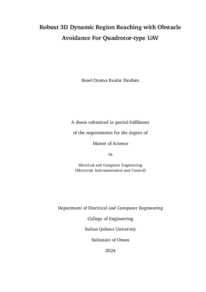وثيقة
Robust 3D dynamic region reaching with obstacle avoidance for Quadrotor-type UAV.
المصدر
Master's thesis
الدولة
Oman
مكان النشر
Muscat
الناشر
Sultan Qaboos University
ميلادي
2024
اللغة
الأنجليزية
نوع الرسالة الجامعية
Master's thesis
الملخص الإنجليزي
This thesis provides an extensive investigation of quadrotor dynamics control, specifically emphasizing translational and attitude control through the implementation
of various advanced techniques. The quadrotor system is represented as a sophisticated multi-input multi-output (MIMO) system, with distinct sets of equations
governing the dynamics of translation and attitude. A novel control technique is
presented for translational dynamics, incorporating backstepping, region-reaching
strategies, and obstacle avoidance. Backstepping is employed to develop a stable
control law that ensures convergence to a predefined region in three-dimensional
space while avoiding obstacles. The proposed control strategy employs artificial
potential functions to guide the quadrotor through a dynamic environment safely.
Based on the backstepping method, the region-reaching controller exhibits the capability to accurately follow desired trajectories while effectively avoiding potential
obstacles, thereby guaranteeing the safety and dependability of quadrotor navigation. A modified terminal sliding mode control approach is used in attitude dynamics. Integrating a Radial Basis Function (RBF) neural network enhances this technique by effectively handling uncertainties and disturbances. The revised terminal
sliding mode controller guarantees the quadrotor’s stable control over its attitude,
even when faced with external disturbances and uncertainties in the model. The
RBF neural network is employed to adjust the control inputs, allowing the quadrotor to achieve accurate attitude control, which is crucial for tasks such as aerial
photography, surveillance, or any other application requiring stable positioning.
The simulations are performed utilizing MATLAB/Simulink, which offers a virtual
setting for testing and verifying the suggested control methods. The results indicate
that the backstepping-based region reaching and modified terminal sliding mode
control strategies are effective and robust. This suggests that these strategies have
the potential to be applied in real-world quadrotor systems. This study makes a
valuable contribution to the progress of quadrotor control systems by introducing
novel methods to handle translational and attitude dynamics. The research places
a significant focus on ensuring safety and achieving high levels of accuracy.
قالب العنصر
الرسائل والأطروحات الجامعية

